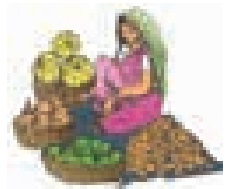Term 2 Chapter 3 | 6th Maths - Bill | 6th Maths : Term 2 Unit 3 : Bill, Profit and Loss
Chapter: 6th Maths : Term 2 Unit 3 : Bill, Profit and Loss
Bill
Bill
Kothai is getting ready for Term II studies in her
school. Her mother gives Kothai ₹300 to purchase the stationery items like note book,
pen, pencil, geometry box etc. Kothai
purchased some stationery items and brought home the following bill.

From the above bill, Kothai understands that the
bill has the following details.
1. Name of the shop.
2. Serial number of the bill.
3. Date on which the bill is produced.
4. The list of items purchased.
5. Cost of each item.
6. Total number of items purchased.
7. Amount paid for the purchase.
8. Tax details.
After the purchase, she has some amount left with
her. She wants to verify whether the expenses made by her are correct.
1. Verification of Bill
Kothai verifies the above bill as follows :
Item 1. 21 × 3 = 63 ✔
Item 2. 35 × 2 = 70 ✔
Item 3. 15 × 2 = 30 ✔
Item 4. 5
× 1 = 5 ✔
Item 5. 52 × 1 = 52 ✔
220 ✔
Think
If 55 bills are produced on a
day, then which information is same on all the bills?
Kothai’s father asks some questions about the bill
and Kothai answers him as follows.
(i) How many notebooks are purchased? 3
(ii) hat is the cost of each pen? ₹30
(iii) hat is the amount paid for pencils ? ₹30
(iv) How much the shopkeeper will give you back
if you give 3 currencies of ₹100? ₹80
Activity
Rasise a few more questions on this bill.
i) How many Erasers are purchased?
ii) What is the cost of each Eraser?
iii) What is the cost of a Geometry Box?
iv) How many materials did Kothai buy?
v) What is the total cost of all items she purchased?
2.
Preparation of a Bill
Arivu purchased the following vegetables from a
petty shop.
2 kg of
Brinjal @ ₹12 per kg, 3 kg of Onion @ ₹16 per kg, 3 kg of Tomato @ ₹20 per kg
and 2 kg of Potato @ ₹24 per kg.

The shopkeeper of a petty shop doesn’t provide the
bill. So, Arivu prepares the bill as follows, which helps him to verify whether
he has paid correct amount for the purchase.

DO YOU KNOW?
@ means ‘ at’.
Think
Will there be any change in the value of the bill if the columns ‘Rate’ and ‘Quantity’ are interchanged?
Example 1:
Ramya purchases some make-up items and gets the following bill.

Observe the bill and answer the following questions.
(i) What is the bill number ?
(ii) Mention the date of the bill.
(iii) How many different items were purchased?
(iv) What is the cost of an hair clip ?
(v) What is the total cost of the ribbon?
Solution:
(i) The bill number is 100.
(ii) The date of the bill is 15.05.2018.
(iii) There were four different items purchased.
(iv)The cost of 1 hair clip is ₹15.
(v) The total cost for the ribbon is ₹36.
Note
Most of the bills will have GST in them.
GST stands for Goods and Services Tax, which is a single indirect tax in India which
has been recently introduced to replace all other taxes like Service Tax, VAT, etc.
The GST is imposed at various rates on various items. The GST is of two types. They
are Central GST (CGST) and State GST (SGST).
Example 2:
Prepare a bill for the following purchases
at Aavin sales counter in Coimbatore on
25-06-2018 bearing the Bill number 160.
1. 5 packets Milk Khoa of 100 gm @ ₹40 each
2. 5 packets of Butter Milk @ ₹8 each
3. 6 packets Milk of 500ml @ ₹25 each
4. 5 packets Ghee of 100gm @ ₹40 each

Solution:
1. Milk Khoa
⇒ 5 × ₹40 = ₹ 200
2. Butter
Milk ⇒ 5 × ₹ 8 = ₹ 40
3. Milk ⇒ 6 × ₹25 = ₹ 150
4. Ghee ⇒ 5 × ₹40 = ₹ 200
Total ₹ 590
CASH BILL
AAVIN PARLOUR, COIMBATORE

Related Topics